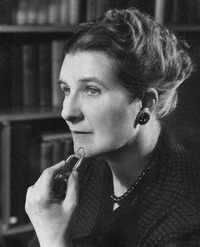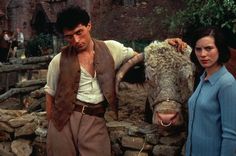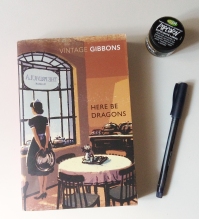
Moodboard inspired by the mc, Nell Sely. (Sources)
Liminal moments are strange. It’s summer, but it isn’t; I’m done with my master’s dissertation, but I’m not; I have a job, but I don’t; I’m nominally grown-up, I have no idea about what I’m supposed to do; I start a blog, and I don’t know how to approach it.
Moodboarding relaxes me: I see pretty things that remind me of other things that I like, and I order them to fit me better. I put up this one yesterday on Twitter, and today I thought: Nell Sely is the character to start this blog with. She’s an adult, but barely. She’s starting a job, but barely. She has no idea about what she’s supposed to do. If she was a contemporary character, she’d be blogging.

- Stella Gibbons in 1955
Here Be Dragons, by Stella Gibbons, was published in 1956. Gibbons was born in London in 1902 and died in 1989 in the same city. Although she published more than 20 novels, as well as short stories, poetry, and journalism (some of it in The Lady, a magazine that I’m dying to study), she’s mostly remembered for her 1932 novel Cold Comfort Farm. That novel is a classic example of a parody becoming more famous than the texts it is mocking, to an extent – in this case, the rural novel in which everybody is related, dialogue is written in imitation of the local dialect, and tragedy ensues. I made the mistake of reading it at the wrong time, when I 1.) Didn’t know it was a parody and 2.) Wasn’t aware of the existence of the genre. Needless to say, I missed most of the jokes. It was funny even like that, but also… Pretty weird. In fact, I just re-checked the plot and it’s set in the future. Yes. It’s… Scifi? And I have no memory of it.

Rufus Sewell broods with his shirt open; Kate Beckinsale is in The Office; there is a cow. (Cold Comfort Farm, 1995)
Much like her novels, though, Here Be Dragons is not really remembered. It tells the story of Nell Sely, who moves with her parents to Hampstead Heath when her father has a crisis of faith and loses his job – hello, North and South. A new girl in the big city at the brink of the Beatles era, she starts working as her aunt’s secretary and meets The Young Cool Set. You know the type – they wear all black, they go to bars, they have artsy professions, they say the 1950s equivalent of “poser” with a straight face. Nell is only halfway through fitting in – she’s way too sensible and relatably uncool – when she realises that what she actually wants to do is dip her toes in another genre entirely – the Coffee Shop AU. Yes. Really. I told you she’d be blogging. Also, a character is described as an “adolescent chicken”, which is possibly one of the clearest defining images I’ve ever encountered.
This is part of what I wrote in my review back in February:
This is a fantastic book to read on a journey, or during a long rainy weekend, when you can dive into it and enjoy every detail.
The setting (1950s London) is absolutely alive and in a couple of sentences I felt that I was part of it; I could see the lights on the canal, the squalid flats, Gardis’ unkempt jumpers. The characters are a delight, even the nasty nasty ones, and the dialogue is witty and sharp. My favourite thing, all in all, is Nell Sely herself. She’s not only a fantastic protagonist, who needs to learn and build her own corner of the world while still being practical and a solid relief among all that sea of artistic coffee drinkers, but she’s also someone I’d love to be friends with.

My copy (a Christmas present from Francesca), with what I found under a minute to represent “the middle”.
The thing with Here Be Dragons, though, is that it’s so in the middle. It’s a story about in-the-middle characters from the (white) middle classes in the mid-twentieth century. It’s good literature, but it’s not a classic. Here we arrive at the complexities of the middlebrow – yes, that’s a dated concept, and a derided one at that, but bear with me for a second. The term “middlebrow”, contrarily to what it might seem, does not necessarily refer to texts produced, aimed at, between the highbrow and the lowbrow – the snob and the pop? – but rather, to those that bring the high to the low – the top to the bop. So it’s an elitist – classist, even – concept: It criticises making the high-end accessible, but it also does not refer to popular culture becoming canonised. Instead, for decades it was meant as “bringing” something (complex topics and forms) down . It’s slippery and complicated – I’m fighting the urge to use “problematic” – and I will be returning to it in future posts.
Should I read Here Be Dragons? Yes, if you enjoy character-driven, witty coming-of-age stories that capture a time period and bring it to life, even if it feels dated at times.
I liked it, but I want something sweeter next. Why not try Nancy Mitford’s Love in a Cold Climate, a sparkly romantic comedy from 1949.
I liked it, but I want something with a sharper bite. Time for Muriel Spark’s Loitering With Intent – a 1981 novel set in 1949 (do you see a theme?) about writing, finding one’s own voice, and being surrounded by kooky artsy people.
I dig the vibe. So do I. Check out An Education (2009) for the main character and the aesthetics, and Frances Ha (2012) for the feeling of being lost in the middle.
What should I read it with and where? Glad you’re asking. On a bench in the park with fresh lemonade in a thermos, or during your daily commute with a latte – no sugar – on the go.
You must be logged in to post a comment.